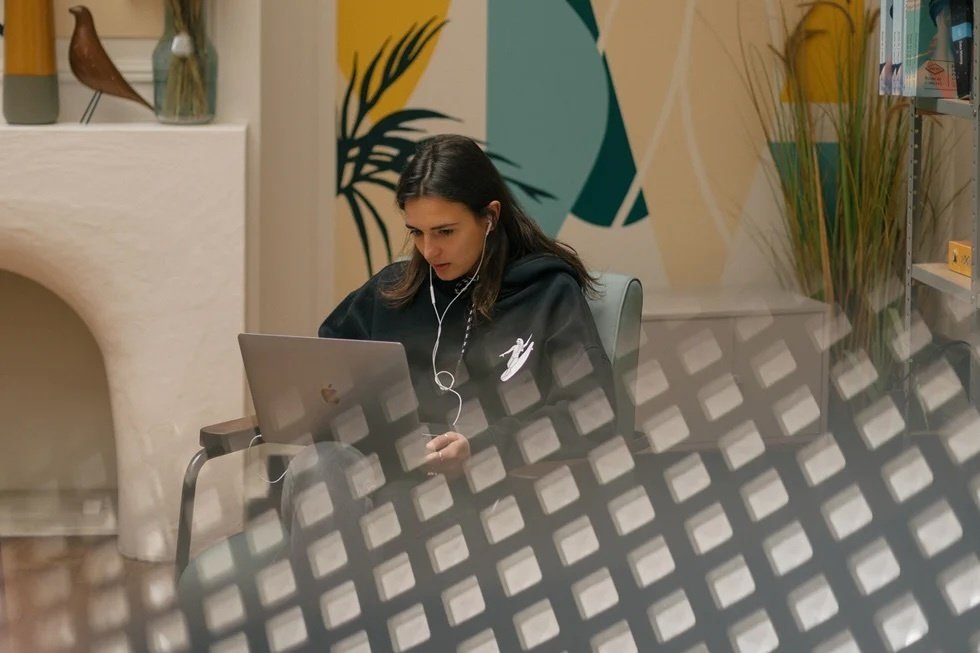Why we can – and should – bring prison labor into the digital age
Mar 20, 2024
7 mins


US Editor at Welcome to the Jungle
More than 1.2 million people are incarcerated in state and federal facilities across the United States, and about two-thirds – nearly 800,000 – of those are engaged in some form of labor. The jobs they do often look similar to those being done by millions of people on the outside. Yet, there’s a stark difference in compensation: The average prison wage peaks at 52 cents per hour and in at least six states — Alabama, Arkansas, Georgia, Mississippi, South Carolina, and Texas — incarcerated individuals are not paid at all for their labor, as highlighted by the American Civil Liberties Union.
Working prisoners tend to be engaged in blue-collar roles, including maintenance, manufacturing, agriculture, and skilled trades. In Florida, for example, they identify and verify license plate tags for the Department of Transportation and issue fines for toll violations. They work 10 hours a day, seven days a week, for 20 cents an hour. If they consistently match their quota, they can earn 55 cents an hour.
While learning a trade can be valuable, prisons don’t offer incarcerated individuals much in the way of knowledge-based education and job opportunities. At the same time, recidivism rates – the tendency to re-offend – continue to be high. More than two-thirds of individuals are rearrested within three years of being released, with half ending up back in jail. Worse still, the most recent large-scale Bureau of Justice Statistics study shows that 83% of released prisoners are re-arrested within nine years.
Those who find employment earn only 53% of the median US worker’s wage in their first few months after being released, rising to 83% over time. Involvement in the criminal justice system can lead to an estimated average lifetime earnings loss of almost $500,000. Having stable, long-term employment has been shown to lower recidivism rates. So what impact could introducing knowledge-based labor opportunities in prisons have on improving recidivism and enhancing employment prospects for incarcerated individuals after release?
Introducing incarcerated individuals to AI algorithims
In Europe, some inncarcerated individuals are employed by tech companies. Finnish startups Vainu and Metroc use these individuals to classify data so as to train artificial intelligence (AI) algorithms. Vainu asks the individuals to identify key information in news articles to aid in algorithm training. Similarly, Metroc uses incarcerated individuals to refine its AI for the construction industry, offering them a glimpse into tech-driven work environments.
Not everyone approves of these programs. Critics argue that the compensation, often less than $2 an hour, is disproportionately low given the value the companies derive from the deal. Additionally, the educational value of the tasks — deemed menial and repetitive — is questioned. Skeptics doubt whether such work prepares incarcerated individuals for other employment in the AI and tech industries upon release.
Despite the issues, these programs show that prison work could be more aligned with today’s digital economy. And it prompts an important question: Could a similar, albeit improved, approach work in the US prison system?
The enduring legacy of incarceration and work
The history of prison labor in the US is a story of exploitation and forced labor, explains Vincenzo Guido, the director of development and communications at Thrive for Life prison project, a non-profit that aims to break the cycle of incarceration. “The passage of the 13th Amendment following the Civil War formally prohibited slavery. However, this Amendment contains a loophole allowing forced labor due to a criminal conviction. Historically, this loophole was exploited, leading to convict-leasing systems where state institutions would lease out labor to private entities,” Guido explains. “These systems were financially lucrative for state systems, as they often transferred costs for food, lodging, and clothing to the businesses leasing incarcerated individuals.”
While much has changed, remnants of this era persist. “In the federal system and most states, incarcerated individuals are typically required to work, often with minimal to no compensation,” he says. Progress toward offering meaningful education and work opportunities within the system has been slow.
From cells to code: Bridging gaps with tech education
Transitioning to employment on the outside can be challenging given the lack of formal certification or credentials, according to Jonathan Wrenn, a formerly incarcerated individual. “Unfortunately, many employers may not value the experience gained in prison,” he says. “Introducing tech [labor] into prisons could shift focus away from manual labor jobs, offering more diverse opportunities for incarcerated individuals… opening doors for those unable to perform physical labor due to disability or other limitations.”
This could be particularly helpful for those who have served long sentences and may not be familiar with new technology, he adds. “Not knowing how to use a smartphone or computer is a huge barrier in today’s world. Introducing them to technology through work or educational programs while incarcerated could ease some of that transition and potentially spark an interest in further learning,” Wrenn says.
Individuals who enroll in postsecondary education programs while incarcerated are 48% less likely to be reincarcerated than those who do not, and those who engage in any form of educational activity in prison are 12% more likely to find employment after their release, according to The Brookings Institute.
So, how can prisons introduce the kind of tech education that can boost incarcerated individuals’ employment prospects in the outside world?
Learning to collaborate on tech education
The jail Wrenn was in didn’t offer any educational programs, so he read books. “I planned to start community college upon my release, and that’s what I did,” he says. “But many universities, such as NYU, Columbia, and Cornell, offer educational programs inside prisons. This includes associate and bachelor’s degree programs, often supported by the Pell Grant reinstatement. Additionally, community colleges are starting to provide courses tailored to incarcerated individuals.”
Guido explains that most of these university programs offer degrees in liberal studies, from labor law to sciences and psychology, with some institutions leaning toward trades. However, other initiatives such as Wrenn’s program, Justice Through Code, through the Center for Justice at Columbia University, focus on coding skills. Wrenn adds that programs like his “aren’t offered inside any prison or facility, [but] they should be.”
Guido says there should be more collaboration between organizations within prisons and universities, especially given the decentralized US prison system. He says this would have the most impact if it involved reputable institutions such as Columbia, NYU, and Cornell, offering programs adapted for inmates. “Overall, while the focus currently leans towards education-based training, the ultimate goal is to equip [incarcerated individuals] with valuable skills for reintegration into society and employment opportunities,” he says.
Why tech companies are different
Wrenn had planned to study finance on being released, but he says it’s tough to break into that industry and the hours are long. Tech offered more. “Tech companies are growing rapidly, and there’s a constant demand for talent,” he says. “They’re often more willing to overlook criminal records and give people a chance. Many tech founders are young and have a different perspective on criminal justice compared to industries with longer histories. So, I see this as a viable option, especially with the increasing number of programs available upon release.” Wrenn has completed two associate degrees, the Justice Through Code program, and is now pursuing his bachelor’s degree in computer science and mathematics at Columbia University.
But one initiative, in particular, is paving the way to bring tech-based labor and education to prisons: The Last Mile (TLM). It was founded in 2010 by Chris Redlitz and Beverly Parenti to empower “justice-impacted” individuals – those who have come into contact with the justice system – with technology-focused education, so they can break the cycle of incarceration by learning skills that are in high demand, such as web development and audio/video production. The programs, which focus on coding languages, website design, and digital editing, prepare participants for the workforce too. They address employment barriers and instill confidence into participants to help them reintegrate into society. This rounded approach means that TLM’s graduates have a recidivism rate of less than 5%.
Before the pandemic, TLM operated a successful web development company at San Quentin, the California State Prison outside San Francisco, under CalPIA’s Joint Venture program. TLM employed incarcerated coding program graduates to develop websites for businesses, including Dave’s Killer Bread Foundation, Coalition for Public Safety, Getting Out & Staying Out, and many others, explains Parenti. The pay is also relatively good too. “The average prison wage is less than a dollar an hour. We were paying $22 an hour. [Plus,] CalPIA donates profits [from the program] to local nonprofits,” says Parenti.
TLM students are involved in some life-changing projects. “We’re also creating social enterprises for graduates to participate in, alongside working with fair chance employers [and] developing apprentice programs with large corporations, focusing on project management and job-specific training for these individuals, preparing them for roles post-release,” explains Redlitz. These interventions are helping their graduates to get on in the tech world, says Parenti. “We proudly have at least five software engineers at Slack, including three senior software engineers who were incarcerated as youths, spending over a dozen years each behind bars,” Parenti adds.
The business has enabled some heartwarming success stories, including instances of women who have been incarcerated for decades creating websites and developing valuable tech skills. One woman returned to her reservation and created websites for the crafts produced there. “These success stories give us hope and reaffirm the importance of our work,” says Parenti.
One such story is Billie Edison, a mother of seven boys. “I knew that I would have a huge challenge finding a job when I got home [from jail] because I have a felony on my record. TLM classes made me realize I could learn something new. I had worked in the medical field for 23 years, so computers were completely out of my comfort zone,” she says. Edison has been an IT apprentice for the Indiana Pacers since November 2023. “Even though the technology work I’m doing is different from what I learned in class, [the] education and experience [from TLM] made me feel like I wouldn’t be here if I couldn’t do it,” she says.
Overcoming barriers: From simulation to employment
The growing interest in education within prisons presents an opportunity, but there are still hurdles to overcome, according to Guido. “Convincing correctional staff, addressing funding limitations, and navigating the privatization of prison services are among the challenges hindering the widespread implementation of tech-related labor initiatives in prisons,” says Guido.
Redlitz adds that teaching software engineering in an environment that didn’t have direct connectivity was challenging for TLM, but they came up with a solution. “We created a simulated coding environment with a cloud-based learning management system, allowing students to access content and code within the classroom as if they were fully online,” says Redlitz. “The primary tool missing is Google. Yet we’ve compensated with a graduate-staffed help desk that responds to queries via a ticketing system, acting as an alternative research resource.” It also uses offline versions of professional software such as Pro Tools and DaVinci for audio/video production, closely mimicking a real environment.
They also want to promote “fair chance” employment, where employment decisions are based on the applicant’s qualifications before seeing their criminal records, and TLM is actively seeking more hiring partners. Redlitz says, “Justice-impacted individuals offer a reservoir of untapped talent that can enrich workplace environments and provide valuable second chances to his overlooked workforce. These roles offer more than employment; they represent a fresh start.”
“People should be judged on the quality of their work, not the stigma of their past,” says Parenti. “I guarantee that your readers have made mistakes. Some individuals have simply been luckier than others in not getting caught for their mistakes. It’s time for society to rise up and recognize that there are a lot of people who never had a fair chance, and it’s our time to give them that.”
Photo: Welcome to the Jungle
Follow Welcome to the Jungle on Facebook, LinkedIn, and Instagram, and subscribe to our newsletter to get our latest articles every week!

More inspiration: DEI

Sh*t’s broken—Here’s how we fix work for good
Built by and for a narrow few, our workplace systems are in need of a revolution.
Dec 23, 2024

What Kamala Harris’s legacy means for the future of female leadership
The US presidential elections may not have yielded triumph, but can we still count a victory for women in leadership?
Nov 06, 2024

Leadership skills: Showing confidence at work without being labeled as arrogant
While confidence is crucial, women are frequently criticized for it, often being labeled as arrogant when they display assertiveness.
Oct 22, 2024

Pathways to success: Career resources for Indigenous job hunters
Your culture is your strength! Learn how to leverage your identity to stand out in the job market, while also building a career
Oct 14, 2024

Age does matter, at work and in the White House
What we've learned from the 2024 presidential elections about aging at work.
Sep 09, 2024
The newsletter that does the job
Want to keep up with the latest articles? Twice a week you can receive stories, jobs, and tips in your inbox.

Looking for your next job?
Over 200,000 people have found a job with Welcome to the Jungle.
Explore jobs